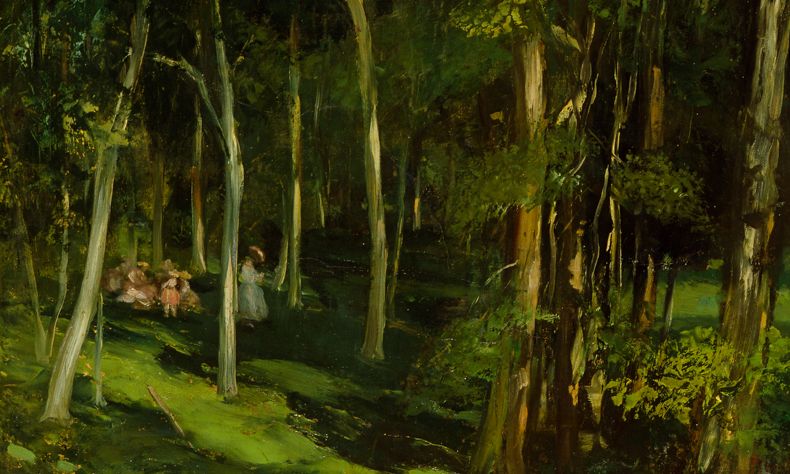Gustave Courbet's La Ronde Enfantine (around 1863)
© The Fitzwilliam Museum, Cambridge
Seized by the Nazis in occupied France, a painting by Gustave Courbet currently in the collection of the Fitzwilliam Museum in Cambridge, UK, will now be returned to the descendants of the original Jewish owner. La Ronde Enfantine (1862), which has the translated title Beneath the Trees at Port-Bertaud: Children Dancing, will be restituted to the Mondex Corporation (which helps clients with the recovery of art looted during the Second World War) on behalf of the heirs of Robert Bing.
According to a report issued by the UK Spoliation Panel which considers claims for cultural property lost during the Nazi era: “La Ronde Enfantine was seized from the flat of Robert Léo Michel Lévy Bing [in] Paris on 5 May 1941 by two members of the Einsatzstab Reichsleiter Rosenberg, ERR [which trafficked plundered art] as part of the Nazi dispossession of Jews in occupied France”.
The painting’s provenance is intriguing; its first owner was Etienne Baudry, Courbet’s local patron in Saintes, western France. Bing’s maternal grandmother, Clara Simonette Ballin (1845-1930), who married the wealthy banker, Alfred Grunebaum, is believed to have later acquired the work.
“In support of the submission that his widow was a collector of art at this time the claimant [of the restitution] draws attention to a catalogue raisonné by Alfred Robaut of the work of [the artist Camille] Corot published in three volumes in Paris in 1905 which refers… to a painting from the collection of ‘Mme Veuve Alfred Grunebaum’,” the panel report says.
The painting was then seized in 1941 by the ERR which “recorded in a document located by the claimant in the federal archive held at Koblenz in Germany […] the looting of the property […] describing the painting as ‘Courbet signed Waldlandschaft [which means forest painting]”.
Crucially, our research last year explored the possibility that the work may then have been acquired as looted art by Hitler’s deputy Hermann Göring who considered a picture swap with the German foreign minister Joachim von Ribbentrop, a collector with a penchant for French 19th-century paintings.
The panel report adds: “The painting has a somewhat colourful history after it was seized. It was held in the Jeu de Paume [in Paris] for the benefit of the leading Nazi collector, Hermann Göring. At one point he proposed to exchange it as part of a transaction involving Ribbentrop, but either the latter or his wife disliked the work and that transaction did not proceed.”
On 1 May 1951, the London dealership Arthur Tooth & Sons acquired the painting from the Swiss art dealer, Kurt Meissner. “On 19 November 1951 Arthur Tooth & Sons sold the painting to the then Dean of York, The Very Reverend Eric Milner-White (1884-1963). He in turn donated it in the same year to the Fitzwilliam Museum in memory of the donor’s father,” the report adds.
The museum says that the research conducted on the painting’s provenance at the time of receipt of the gift was consistent with the methods and norm of the time. “The museum has some 500,000 objects in its collection, including around 2,000 paintings. At the time of the gift there would have been little to arouse suspicion. Not only was The Very Reverend Eric Milner-White an Anglican Priest but he was a generous donor of some 50 paintings to public collections in the United Kingdom and had been awarded both the [military decoration] DSO (unusually for a clergyman) and a CBE,” the panel report says.
The Fitzwilliam Museum says it will follow the recommendations set by the panel. “This recommendation implies no criticism of the museum or the original donor, The Very Reverend Eric Milner-White, who have acted honourably and in accordance with the standards prevailing at the time of acquisition and since. The museum has cared for the work so that it can now be restored to the heirs of the original owners.”

